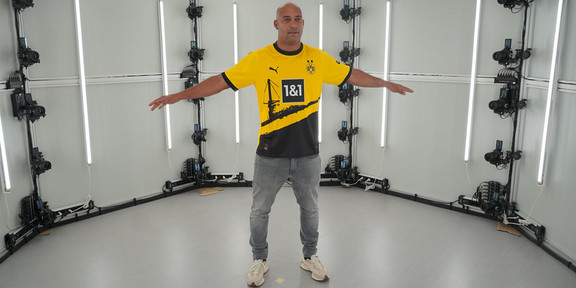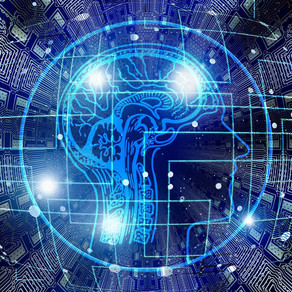Digital avatar for BVB legend Dedê
- News

A special visit to the TU campus: Dedê, former Borussia Dortmund full-back, had a photorealistic digital avatar made of himself at the Hybrid Learning Center (HyLeC). This can currently be seen in a special exhibition at the BORUSSEUM to mark the 50th anniversary of the BVB stadium.
Wearing a black and yellow jersey with his regular number 17, the 45-year-old Brazilian stands in the personal scanner in the HyLeC: a white, well-lit cabin in which a total of 60 high-resolution cameras are installed all around the walls and even up on the ceiling. Stephan Wenninger, a member of staff at the Chair of Computer Graphics, gives the final instructions: "Please spread your arms out once, keep a neutral expression on your face, keep your mouth closed, don't smile and don't grimace - then you're ready to go!" Wenninger leaves the booth and closes the door behind him. With one click, all 60 cameras take a picture of Dedê at the same time.
The data flows directly into the computer next door, where the work process can be followed live on the computer screen: A body model, which initially consists only of a grey average human, gradually fills in with contours, colors and details. "Creating avatars used to take several days and involved a lot of manual work," says Prof. Mario Botsch, Chair of the Faculty of Computer Science. "Now, thanks to our AI-supported process, it takes just a few minutes and is fully automated."
From video games to medical therapy
Botsch is a professor of computer graphics and geometry processing and is developing new methods for creating avatars - for example, a process that can be used to create avatars using a smartphone. Avatars have attracted a lot of attention in recent years, for example through the video game "Cyberpunk 2077", which features an avatar of Hollywood actor Keanu Reeves. But they are more than just a gimmick: in ViTraS and VIA-VR, two cooperation projects with the Julius-Maximilians-Universität Würzburg funded by the Federal Ministry of Education and Research, in which Prof. Botsch is involved, they are used for medical therapies using virtual reality (VR). In the obesity project ViTraS , for example, avatars of overweight people are created. Patients can then move in front of a virtual mirror, so to speak, and observe the effects of a simulated weight change.
Dedê's avatar is ready after a short time. Anyone who wants to experience the digital footballer can do so at the BVB Museum, the BORUSSEUM, until October. A special exhibition is currently on display there to mark the 50th anniversary of the BVB stadium, in which Dedê's avatar is being used as an augmented reality element. Students and TU employees can also have their own avatar created in the HyLeC's personal scanner. Their scan data can help to improve the data-driven AI models and make them more widely applicable.

![[Translate to English:] [Translate to English:]](/storages/zentraler_bilderpool/_processed_/d/f/csm_Informatik_275ba5e5fc.jpg)

![[Translate to English:] [Translate to English:]](/storages/zentraler_bilderpool/_processed_/1/b/csm_Figuren-nachdenklich_e2435967dd.jpg)
![[Translate to English:] [Translate to English:]](/storages/cs/_processed_/6/f/csm_teamwork1_e113f5f13b.png)
